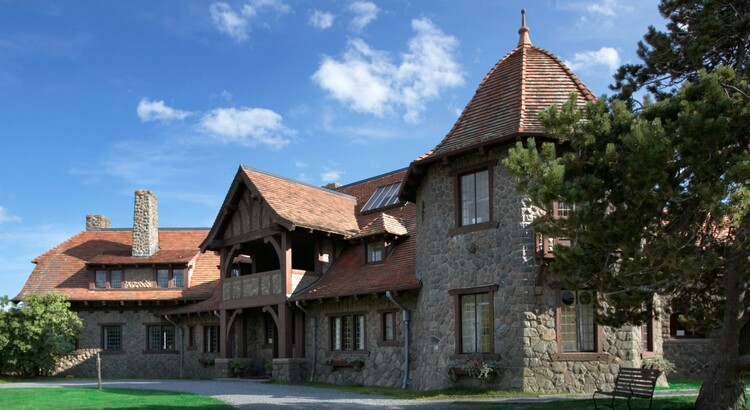


Hello, and welcome to the Castle in the Clouds audio tour. We will begin our tour outside, facing the mansion’s mountainside façade. While at this location, be aware that trolleys arrive regularly, and remember to stand on the grass for your safety.
Let’s take a minute to examine the façade of the house.
You’re looking at a 16 room, 10,000 square foot mansion built over 100 years ago in 1914.
Designed by the architectural firm J. Williams Beal & Sons and built in the arts and crafts style, this house is a fascinating blend of both traditional and modern – it pays homage to its beautiful natural setting and to the fast-paced technological advances of the early 20th century.
The Arts & Crafts movement began in England in the mid-19th century, and was a reaction to the industrialization and mechanization of the period. Arts & Crafts was an aesthetic movement in architecture and the arts that celebrated the work of the individual, the craftsman. It focused on art that was functional as well as beautiful, and included a certain reverence for the past and for tradition.
The movement quickly spread across the Atlantic, and American artists and architects developed new branches. For instance, you may have heard of mission style or Frank Lloyd Wright and the Prairie school of architecture, both of which were popular in the late 19th and early 20th centuries.
At the same time in Boston, architects were heavily influenced by the English Arts & Crafts movement, but they created a distinctly New England tradition. The Lucknow mansion falls into this category of New England Arts & Crafts.
It has been reported that Tom Plant contracted as many as three different architects before finding one willing to work with him to create this unusual home on fairly inhospitable terrain.
J. Williams Beal was a Boston-based architect who had previously worked for the famed McKim, Mead and White architectural firm. He was actually nearing the end of his career when he was commissioned to design Lucknow. Beal worked in the Arts and Crafts aesthetic, and we can see several parallels between this home and some of his earlier commissions. He worked closely with Tom Plant to develop the home’s design. After Beal suffered a stroke, his son, John Woodbridge Beal, took over management of the firm and oversaw the completion of Lucknow, traveling regularly to Moultonborough to check on the project’s progress.